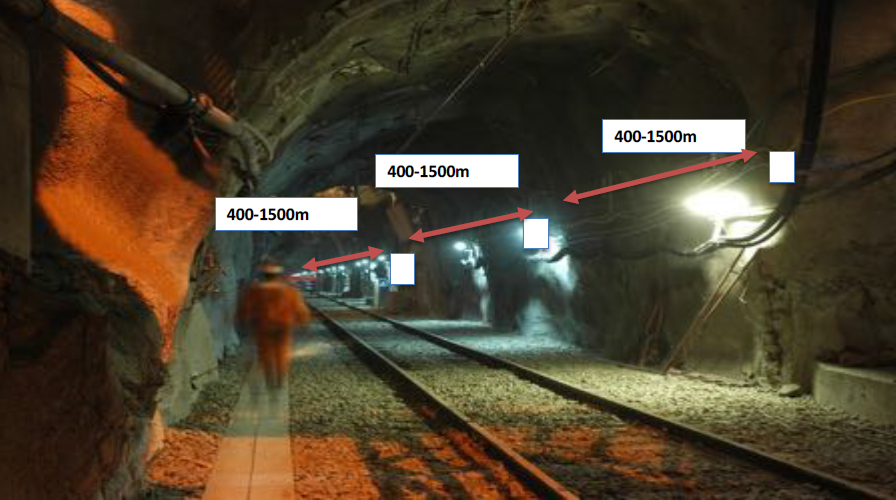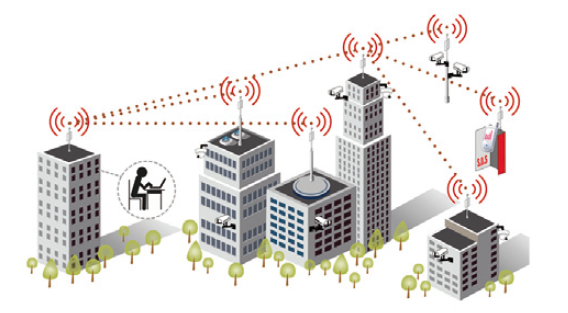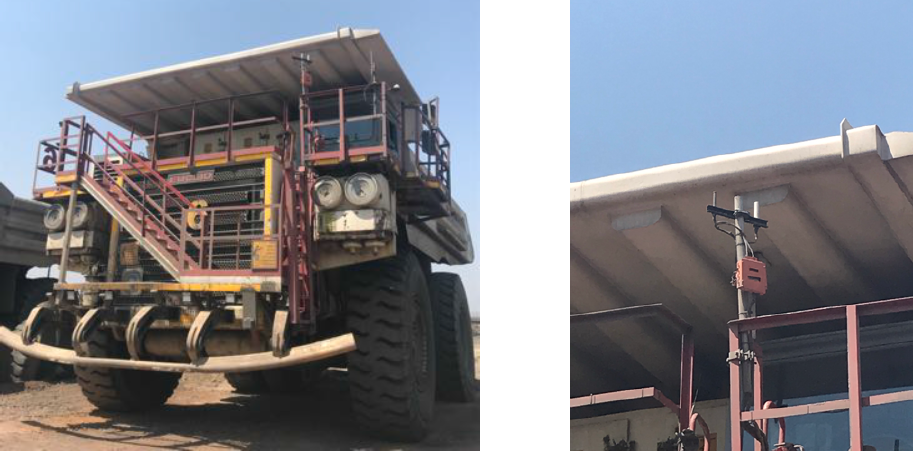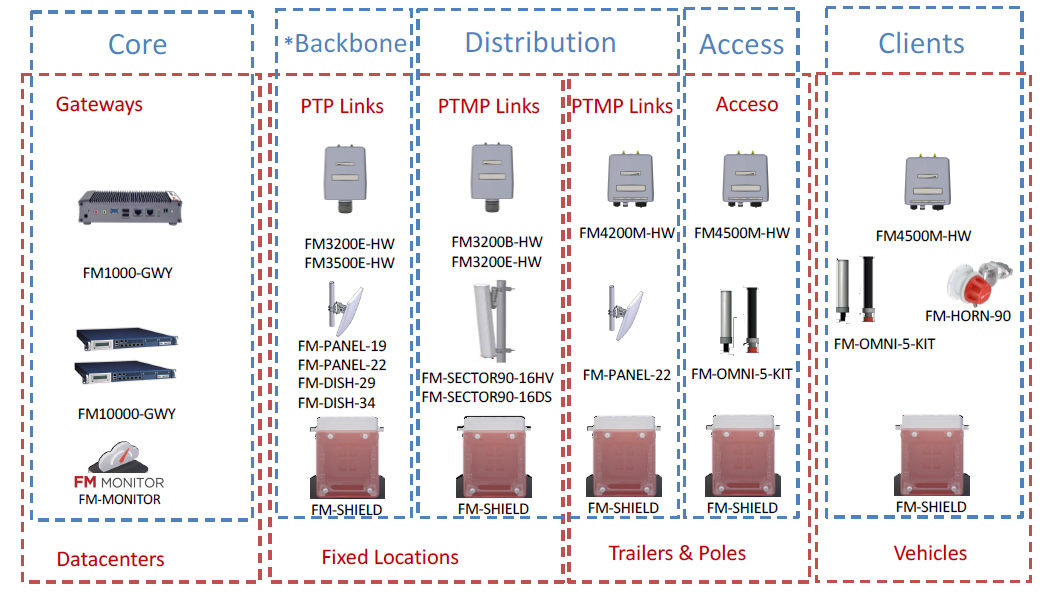
What is it for?
The Cisco Ultra-Reliable Wireless Backhaul solution grew out of the Cisco-acquired manufacturer FluidMesh. It is designed to provide high-speed wireless data transmission over long distances on stationary and moving objects.
Despite the presence of the word Wireless in the name, it is important not to confuse it with the usual Wi-Fi. In Wi-Fi networks, we have access points and standardized client devices - laptops, smartphones, tablets. It happens that instead of a client device, another access point is connected - it turns out a Wi-Fi bridge, you can make a Mesh network from bridges, but this is not exactly what Wi-Fi was invented for and not where it manifests itself best.
In the case of the Ultra-Reliable Wireless Backhaul, we do not have client devices. There are only devices that can receive and transmit data using a special proprietary technology. In order to connect a client device, it is necessary to use an Ethernet switch and / or a Wi-Fi access point by connecting them to the device with an Ultra-Reliable Wireless Backhaul using a cable.

The easiest way is to imagine that we need to connect certain locations with a high-speed cable, but it is expensive, difficult, or, in the case of moving objects, impossible to stretch it. Therefore, we install transceivers and make this "cable" wireless. It turns out the backbone network, in English terminology - Wireless Backhaul.
Examples of using
Fixed point-to-point connection
The simplest example is the same: you need to connect a new building on the territory of, say, a factory to a common network, and it is expensive and time-consuming to lay optics there. The bridge, built on Cisco equipment, will allow you to quickly and cheaply provide connections up to 500 Mbps. If necessary, you can put two pairs of devices and get 1Gbps.
The problem of connecting to the network of construction sites is also solved in the same way. As a rule, it makes no sense to extend the optics here, also because it will most likely be torn.
Fixed point-to-multipoint connection
A good example here is the connection of CCTV cameras in the area around the main building - a factory office, a shopping center, etc. Cameras are most often installed on lamp posts, where the power supply has already been supplied for the sake of the lamps themselves, but the question arises with the connection of the Ethernet cable. To avoid this, you can install the simplest Ultra-Reliable Wireless Backhaul devices along with the cameras and transmit data from each pole to the devices installed on the building.

Vehicles and other mobile objects
Features of the Cisco Unified Wireless Backhaul technology, which will be discussed below, allow you to provide very high quality communication with mobile objects.
- At enterprises that extract minerals in an open way, with its help, communication is organized to collect telemetry and location data from quarry equipment. Stationary Cisco Unified Wireless Backhaul devices with antennas directed inside the quarry are installed along the perimeter of the quarry, and mobile devices with omnidirectional antennas are installed on the equipment. At the same time, the bandwidth is sufficient even to transfer video from cameras installed on machines.

- In mines, the Ultra Reliable Wireless Backhaul can be used to communicate with cars or trains running inside. The scheme is similar: a number of stationary devices are installed in the tunnel to provide coverage, and mobile devices are installed on equipment. For mines, the options for stationary use may also be interesting: distribution of Wi-Fi for workers using tablets, phones, RFID tags, data collection and automation control - ventilation, SCADA devices, etc.

- Communication between the "ground" and a regular passenger train: for distributing Wi-Fi and collecting video surveillance data in the latter.
- Inside the train, the Wireless Backhaul can be used to provide communication between the cars: two devices are installed in different cars with special antennas pointed at each other.
- Reception and transmission of data to elevators in high-rise buildings to ensure the operation of video surveillance, Wi-Fi and transmission of content to monitors located in elevator cars. For such purposes, special expensive and difficult to install cables are traditionally used. A wireless solution can be more reliable and cheaper.
Why do you need a proprietary solution?
It seems that all the tasks described above can be solved using regular Wi-Fi, and for situations where data transmission over long distances is required, LTE. However, a number of problems arise:
In the case of Wi-Fi:
- unpredictable data transfer delay: the Wi-Fi media control algorithm is designed in such a way that client devices exchange data with the access point in turn, gaining access to it in an almost random way. There is no way to guarantee the stability of the data transmission delay. The maximum that the mechanisms for ensuring the quality of data transfer in Wi-Fi are capable of is to reduce the likelihood of sharp fluctuations in data transmission delays for a certain type of traffic, in comparison with others, but in no way guarantee that such fluctuations will not occur at all.
- – Wi-Fi , . Wi-Fi- , . ,
- . , Wi-Fi- 200, .
- (DataRate)
- complex and fine tuning is required to ensure optimal Wi-Fi performance
- the availability of devices for intercepting and analyzing Wi-Fi traffic in many cases makes it available to hack Wi-Fi networks
In the case of LTE:
- asymmetric bandwidth. Download bandwidth is wider than Upload.
- unpredictable latency of data transfer, as is the case with Wi-Fi
- the maintenance of the wireless network will have to be entrusted to the telecom operator. The operator may not provide fast enough troubleshooting, especially if your network is located in a hard-to-reach location, such as a quarry in Eastern Siberia. It will not be possible to close this need with your own specialists.
- if the coverage of the base stations already available to the operator turns out to be insufficient, the installation of additional, even mobile ones, greatly increases the costs, and therefore the cost of the service for its customer.
In addition, there may be problems associated with manifestations of the Doppler effect when communicating with vehicles if the latter are moving at high speeds.
How does it work?
The Ultra-Reliable Wireless Backhaul solution is not unique in the sense that other manufacturers offer implementations of core networks based on proprietary wireless data transfer protocols. What is so special about Wireless Backhaul?
Physics from Wi-Fi
The physical layer of data transmission is implemented on chips completely similar to those used in the latest generation Wi-Fi devices (IEEE 802.11ax). This means that both frequencies and data transmission channels are used the same, which means, from the point of view of regulators, installing a FluidMesh device looks like installing an access point broadcasting in the unlicensed 5 GHz band.
Unlike conventional Wi-Fi, the physics of the Ultra-Reliable Wireless Backhaul is capable of providing MIMO even over very long distances.
"Logic" from operator communication networks
At the data link and network layers, Bakchaul's Ultra-Reliable Wireless solution uses a protocol called PRODIGY 2.0, which is based on MPLS. MPLS is a data transmission technology in telecom operators' networks that provides high performance and good manageability of such networks. The use of such a protocol allows ensuring the quality of traffic processing - first of all, predictable transmission delay, which is so important for audio, video and real-time telemetry. For priority applications, the delay is less than 0.3ms.
Bandwidth
The available bandwidth of the point-to-point connection is up to 500 Mbps. Ultra-Reliable Wireless Backhaul devices are able to select DataRate so that it does not change unpredictably when distance or handover changes, as it happens in Wi-Fi networks.
PRODIGY 2.0 protocol has advanced handover mechanisms - switching from one base station to another. In regular Wi-Fi, switching occurs as follows: when the noise / signal ratio falls below the threshold value, the client device switches to another available access point with the maximum noise / signal ratio. At the same time, this client device does not know anything about how well the connection with the new point will work. In addition, as mentioned above, in order to switch to a new point, it must first break the connection with the previous one, that is, there is a period of time, albeit a short one, during which data cannot be transmitted. Even with the so-called “seamless” handover. In the PRODIGY 2.0 protocol on Ultra-Reliable Wireless Backhaul devices, switching is implemented differently:exchanging data with the current base station, the device searches for the second available one, establishes a connection with it, tests it, and only then switches the data stream to it.
Rebuilding Mesh Network on Failure
Mesh networks are built from a number of wireless access points or base stations that transmit data from one to another. In the event of a failure of one of the devices, its neighbors should promptly rebuild data transmission through the other available ones, if possible. Ultra-Reliable Wireless network rebuilds in less than 500ms.
Safety
Everything is simple here: in addition to the built-in traffic encryption mechanisms using AES, data transmission using a proprietary protocol remains invisible to Wi-Fi analyzers. An attacker will also fail to replace the base station in order to connect to your network - the authentication mechanism protects against this.
The Frequency Hopping mechanism protects against attempts to drown out the network with noise.
PROFINET support
Ultra Reliable Wireless Backhaul is able to correctly transfer packets related to the operation of the widespread industrial automation protocol PROFINET. The technology can also be used in PROFINET Conformance Class B networks.
Network structure
With simple cases, like point-to-point connections, everything is clear. The structure of a large Ultra Reliable Wireless Backhaul network is easiest to understand by analogy with Wi-Fi.

The network itself is built from base stations - these are analogs of access points.
Gateways perform aggregation of MPLS traffic and are its exit point to the enterprise network. Gateways are not a necessary part of the solution, since they are not a wireless controller in the understanding of Wi-Fi solutions. Each base station can act as a gateway, but the bandwidth is limited to 500 Mbps. If you need a total bandwidth of more than 500 Mbps, then you need to install a gateway. Gateways are available for 1Gbps and 10Gbps bandwidth.
In addition to all this, the FM-Monitor monitoring system and the RACER control system - an analog in Wi-Fi - Cisco Prime Infrastructure or DNA Center are attached.
This is where the Wi-Fi analogy ends. In terms of the interaction of access points with each other, the network is more like a wired Ethernet network:
- The most high-performance base stations form the core of the network - the Backbone;
- Less productive - form a distribution level - Distribution. This layer connects to the Backbone and brings connections to the access layer;
- Access level - broadcasts for end clients - mobile and stationary, from which it is necessary to collect and to which it is necessary to send data (Clients).
Instead of a conclusion
This post, of course, does not exhaust the topic of wireless technologies. And if you're interested in learning more and asking questions to our wireless experts, come listen to our webinar on June 29th . There we will talk about both Wi-Fi and Ultra Reliable Wireless Backhaul. Let's analyze in which scenarios it is worth using the first technology, in which the second, and in which both.